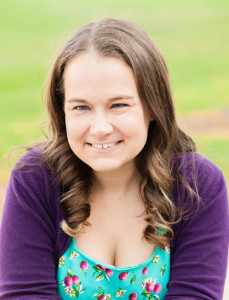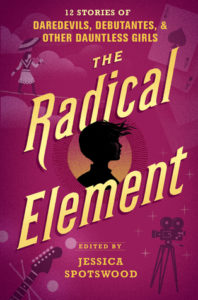 Last week, I reviewed The Radical Element, a collection of 12 short stories about young women, outsiders in American history, who take charge of their lives and destinies. Today, I am pleased to host the anthology’s editor, Jessica Spotswood, for an interview to coincide with the book’s first week of publication. Congratulations, Jessica and contributors!
Last week, I reviewed The Radical Element, a collection of 12 short stories about young women, outsiders in American history, who take charge of their lives and destinies. Today, I am pleased to host the anthology’s editor, Jessica Spotswood, for an interview to coincide with the book’s first week of publication. Congratulations, Jessica and contributors!
How did you come up with the idea for The Radical Element? How do you see it as different from its 2015 predecessor, A Tyranny of Petticoats?
I wanted to explore the idea of being radical – which Webster’s defines as “very different from the usual or traditional” – via girls who were unusual in their communities, whether by virtue of their race, religion, sexuality, disability, gender, or the profession they were pursuing. Tyranny focused a little more on adventures, on being brave and badass in bigger, more obvious ways. We had stories about sisters running a saloon in a lawless Alaskan town (Y.S. Lee), a spy during the Civil War (Caroline Tung Richmond), and a bank robber during the Great Depression (Saundra Mitchell). The heroines of The Radical Element are no less badass, but the stories focus more on personal turning points. When and why might girls throughout history have to fight for their beliefs? Where do they explode tradition, and where do they decide to embrace it?
How did you recruit the authors for this new anthology? Did any of them seek you out after having appreciated A Tyranny of Petticoats?
I don’t think anyone specifically sought me out. I reached out to them because I admired their work and because I specifically wanted to include more marginalized voices than I had in Tyranny. For Tyranny I had asked primarily authors of historical fiction and historical fantasy, plus a few authors (Marie Lu, Marissa Meyer, Beth Revis) who had wonderful science fiction or fantasy world-building skills that I thought would translate well to historical fiction and who I hoped would bring their sizable audiences along to a new genre. This time I sought out more of my favorite authors of historical fiction (Erin Bowman, Stacey Lee, Mackenzi Lee, Meg Medina, Megan Shepherd, Sarvenaz Tash) but also branched out to ask some of my favorite contemporary authors (Dahlia Adler, Sara Farizan, Marieke Nijkamp).
 This new volume features mostly own voices authors. Did you suggest specific periods or topics, or did they come to you with their ideas?
This new volume features mostly own voices authors. Did you suggest specific periods or topics, or did they come to you with their ideas?
Before they started writing, I asked each of them to create a short story pitch. The parameters were simple: the story should be between 5000-7000 words and feel as though it could not take place anywhere or anywhen else. It should feature a girl who was an outsider in her community in some way. I encouraged them to think inclusively regarding race, sexuality, religion, and ability. I didn’t suggest any specific periods or topics. There ended up being a few gaps – for instance, while half of the authors identify as queer, we don’t have any stories with a f/f romance this time around. And I wish we had a story set in early modern America, before the 1820s – originally we had an author planning to write a Revolutionary War story, but she dropped out early on. If I get to do another anthology, I would keep those potential gaps in mind early in the process.
In contrast to A Tyranny of Petticoats, which balances historical fantasy and realistic stories, all but two stories in this collection—Anna-Marie McLemore’s “Glamour” and Dhionelle Clayton’s “When the Moonlight Isn’t Enough”—are realistic. Why do you think this happened?
That’s a really good question. I’m not sure. I think more of the authors I tapped this time around write primarily realistic fiction, whether it’s historical or contemporary. I love writing magic but even I went “straight” historical this time around.
Tell me some of the most memorable new things you learned about U.S. history from editing this collection.
Embarrassingly, I didn’t know anything about the Mormon exodus and their persecution before I edited Mackenzi Lee’s story. I learned about the Buck v Bell case and some of the ugly realities of the eugenics movement from Marieke Nijkamp’s story. Really, I learned something from each story. Unfortunately, the history I learned growing up was almost exclusively that of men (and straight white Christian men at that) and excluded a lot of the voices represented in our stories.
What would you like readers to take away from this collection?
I hope that, in reading about our radical girls, readers will question why characters like these are so often missing from traditional history lessons. They have always existed. Why have they been erased? How can we all help boost these voices today? Most of all, I hope our readers will come away with the sense that their own voices are worth fighting for, and that it’s vital to speak out against racism, homophobia, xenophobia, ableism, and any other injustices they see.
Along with editing A Tyranny of Petticoats and The Radical Element, Jessica Spotswood is the author of the contemporary novel Wild Swans and the historical fantasy trilogy The Cahill Witch Chronicles. She grew up in a small town in Pennsylvania and currently lives in Washington, D.C.